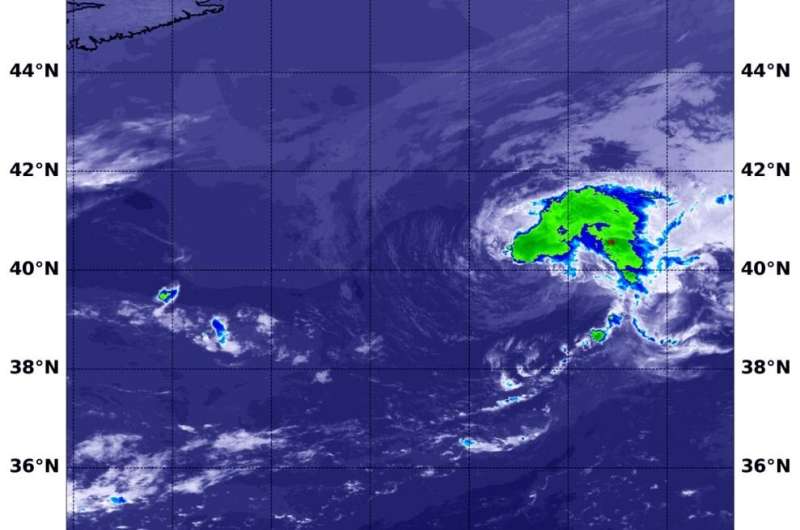NASA sees a lopsided Atlantic Tropical Storm Chantal form

NASA's Aqua satellite provided a view of newly formed Tropical Storm Chantal in the North Atlantic Ocean. The image revealed that the storm formed despite being battered by outside winds.
The third named storm of the Atlantic Ocean hurricane season formed around 11 p.m. EDT on Aug. 20, far from land and almost 500 miles southeast of Halifax, Nova Scotia, Canada.
NASA's Aqua satellite obtained an infrared view of the storm nine hours later. An instrument aboard Aqua uses infrared light to analyze the strength of storms by providing temperature information about the system's clouds. The strongest thunderstorms that reach high into the atmosphere have the coldest cloud top temperatures.
On Aug. 21 at 8:20 a.m. EDT (1220 UTC), the Moderate Imaging Spectroradiometer or MODIS instrument that flies aboard NASA's Aqua satellite gathered infrared data on Chantal. The strongest storms were east of the center of circulation and indicative of vertical wind shear, outside westerly winds pushing against the storm. Storms east of the center had cloud top temperatures as cold as minus 50 degrees Fahrenheit (minus 45.5 Celsius).
In general, wind shear is a measure of how the speed and direction of winds change with altitude. Tropical cyclones are like rotating cylinders of winds. Each level needs to be stacked on top each other vertically in order for the storm to maintain strength or intensify. Wind shear occurs when winds at different levels of the atmosphere push against the rotating cylinder of winds, weakening the rotation by pushing it apart at different levels.
At 11 a.m. EDT (1500 UTC), the center of Tropical Storm Chantal was located near latitude 40.2 degrees north and longitude 51.6 degrees west. The center of Chantal is about 455 miles (730 km) south of Cape Race, Newfoundland, Canada.
Chantal is moving toward the east near 20 mph (31 kph). A turn toward the southeast with a decrease in forward speed is expected by Thursday, August 22. Chantal is forecast to slow further and turn southward on Friday. Maximum sustained winds are near 40 mph (65 kph) with higher gusts. The estimated minimum central pressure is 1009 millibars.
NOAA's National Hurricane Center anticipates gradual weakening and Chantal is forecast to become a tropical depression in a couple of days.
More information: For updated forecasts, visit: http://www.nhc.noaa.gov
Provided by NASA's Goddard Space Flight Center




















